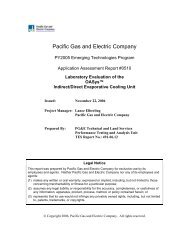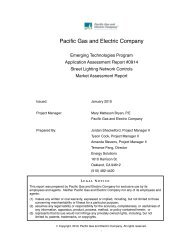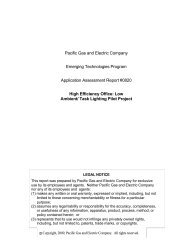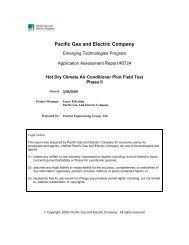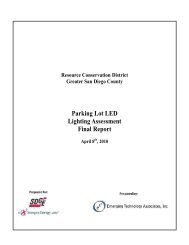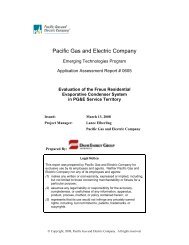Download the project report.
Download the project report.
Download the project report.
Create successful ePaper yourself
Turn your PDF publications into a flip-book with our unique Google optimized e-Paper software.
• Energy Factor<br />
The emphasis was mostly on <strong>the</strong> operation, as <strong>the</strong> test lab lacked <strong>the</strong> environmental control needed to test<br />
within <strong>the</strong> tolerances needed for producing a performance rating. Of secondary importance was to<br />
determine how system performance is affected by <strong>the</strong> operating conditions of ambient temperature and<br />
humidity and tank temperature setpoint.<br />
METHODOLOGY<br />
Thermodynamics and Terminology<br />
A heat pump uses <strong>the</strong> familiar refrigeration cycle to move <strong>the</strong>rmal energy “uphill” from a low temperature<br />
source to a high temperature sink. For an air conditioner, <strong>the</strong> cool space where energy is absorbed would<br />
be <strong>the</strong> interior of a building or car, and <strong>the</strong> warm space where <strong>the</strong> energy is discharged is <strong>the</strong> ambient air.<br />
For a heat pump water heater, <strong>the</strong> warm space for energy discharge is <strong>the</strong> water in <strong>the</strong> tank, while <strong>the</strong><br />
cooled space for absorbing energy is <strong>the</strong> room air around <strong>the</strong> water heater or from some o<strong>the</strong>r source<br />
(such as a water loop used in a ground-source heat pump).<br />
All refrigeration cycles contain four basic components: an evaporator to absorb energy, a condenser to<br />
reject energy, a compressor to raise <strong>the</strong> pressure and create flow, and an expansion device to control <strong>the</strong><br />
flow. The system works with a fluid, or refrigerant, that evaporates (transitions from a liquid to a vapor)<br />
at a low pressure and temperature, and condenses (transitions from a vapor back to a liquid) at a<br />
reasonably high pressure and temperature. The majority of <strong>the</strong> energy consumed is <strong>the</strong> input to <strong>the</strong><br />
compressor, with smaller contributions from devices that move <strong>the</strong> heat absorption or rejection medium<br />
through <strong>the</strong> evaporator or condenser (such as air or water). The energy rejected at <strong>the</strong> condenser is <strong>the</strong><br />
sum of <strong>the</strong> energy absorbed by <strong>the</strong> evaporator and <strong>the</strong> energy consumed by <strong>the</strong> compressor. Since heat<br />
pump efficiency is measured as <strong>the</strong> heat rejected divided by <strong>the</strong> total input energy (compressor and fans<br />
or pumps), values in excess of 100% are possible, with numbers approaching 300-400% achievable in<br />
some cases.<br />
Expansion Valve<br />
Figure 1: Basic Refrigeration Cycle<br />
Heat Absorbed<br />
(from ambient air)<br />
As a <strong>the</strong>rmodynamic heat engine in reverse, <strong>the</strong> heat transfer capacity, <strong>the</strong> amount of compression energy<br />
required, and thus <strong>the</strong> system efficiency, are all a function of <strong>the</strong> evaporating and condensing temperature<br />
difference. As ei<strong>the</strong>r <strong>the</strong> condensing temperature rises or <strong>the</strong> evaporator temperature drops, energy<br />
consumption increases, and capacity and efficiency both decrease. When applied to a heat pump water<br />
heater, in order to keep <strong>the</strong> electric energy input low and efficiency high, <strong>the</strong> evaporator temperature<br />
491-09.17.doc 8<br />
Condenser<br />
Evaporator<br />
Heat Rejected<br />
(to <strong>the</strong> water in<br />
a HPWH tank)<br />
Compressor<br />
Electric<br />
Energy



